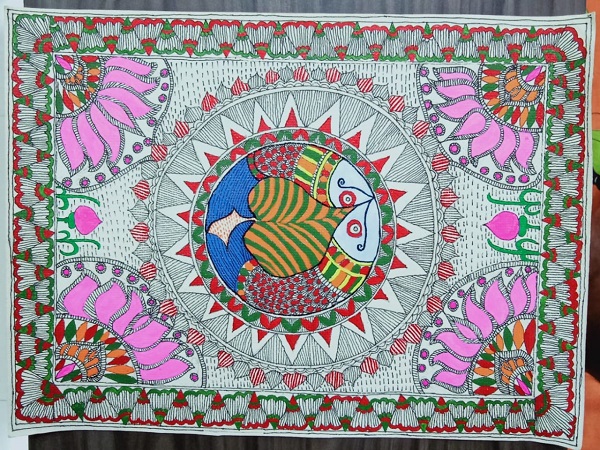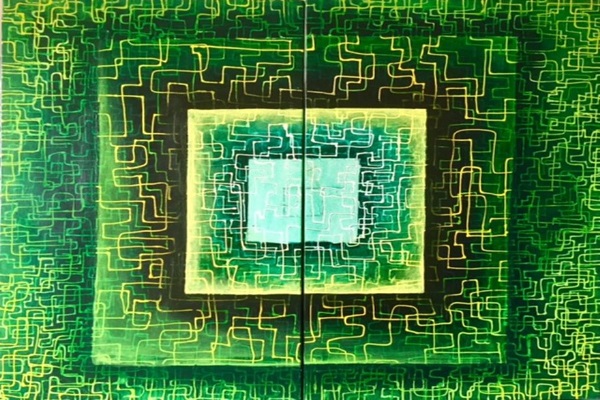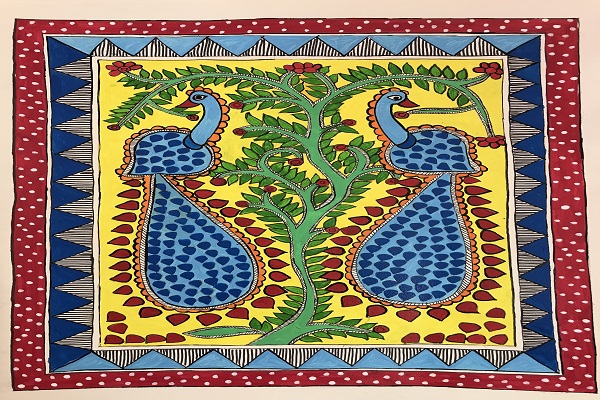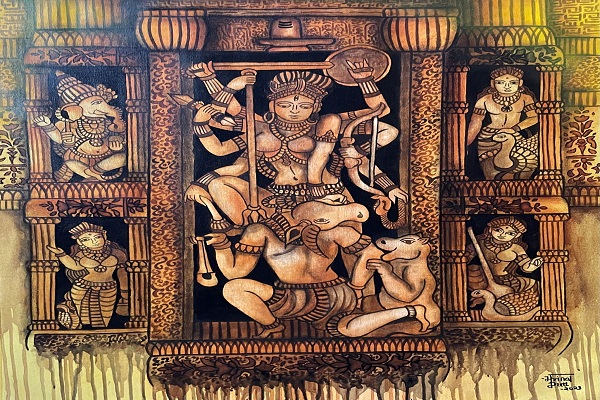
Nestled within the heart of South Asia, India boasts an art legacy that spans epochs, capturing the essence of a nation rich in cultural diversity and historical depth. From the intricacies of Mughal miniatures to the bold strokes of modern abstraction, every piece of Indian art tells a story etched in time. As we embark on this journey through the corridors of creativity, it becomes evident that buying Indian art is a venture deserving of insight and guidance.
How does one navigate an Indian art gallery, where centuries-old techniques coalesce with contemporary expressions? Here lies the art collector's conundrum for buying Indian art.
Understanding the Rich Indian Art
India, a land steeped in history, culture, and diversity, has given birth to an art scene as varied as its landscapes. To truly appreciate Indian art is to embark on a journey through a kaleidoscope of forms, each imbued with the echoes of centuries.
Overview of Diverse Art Forms in India
India, with its myriad communities, languages, and customs, boasts an astonishing variety of art forms. From the intricate brushwork of miniature paintings to the grandeur of monumental sculptures, every stroke tells a story. Traditional art forms like Madhubani from Bihar, Tanjore paintings from the south, and Pattachitra from Odisha are just a glimpse into this diverse world. Modern and contemporary artists, inspired by this rich heritage, contribute to an evolving narrative that spans classical to avant-garde.
Influence of Culture, History, and Traditions on Artistic Expressions
The canvas of Indian art is woven with the threads of its vibrant culture, complex history, and enduring traditions. Each stroke on a canvas or chisel on stone reflects a cultural narrative passed down through generations. The influences of Mughal, Rajput, and Dravidian cultures are evident in the art forms that emerged during different periods. The deep connection to spirituality, rituals, and folklore infuses Indian art with a sense of identity and purpose.
Recognizing Unique Styles and Techniques of Indian Artists
Indian artists, like poets with paintbrushes, employ unique styles and techniques that distinguish them on the global stage. The exquisite detailing of Mughal miniatures, the bold strokes of Bengal School paintings, and the harmonious blend of spirituality and abstraction in contemporary works showcase the versatility of Indian art. Across diverse mediums—be it oils, watercolors, sculptures, or textiles—artists adeptly navigate tradition and innovation. As a result, it creates a visual language that resonates with a global audience.

Identifying Your Artistic Preferences
When buying Indian art, the journey begins with self-discovery — understanding your artistic preferences. This pivotal step shapes not only the pieces you choose to adorn your space but also the stories you invite into your life. Whether drawn to the nostalgia of traditional art or the avant-garde allure of contemporary pieces, understanding your personal taste is about acknowledging what resonates deep within.
Exploring Traditional vs. Contemporary Indian Art
Traditional Indian art carries the echoes of centuries, telling tales of cultural heritage and artistic legacies. From the intricate details of Mughal miniatures to the vibrant narratives of Madhubani paintings, traditional artworks serve as windows to India's rich past. Exploring this realm offers a journey through folklore, spirituality, and the craftsmanship of bygone eras.
On the flip side, contemporary art ventures into the uncharted territories of modernity. Artists experiment with diverse styles, pushing boundaries and challenging norms. It's a canvas where boldness meets innovation, where artists weave narratives that resonate with the complexities of the present. Exploring contemporary art opens doors to fresh perspectives, reflecting the ever-evolving nature of the artistic landscape.
Understanding Different Mediums
Buying Indian art necessitates an exploration into the realm of both historical luminaries and contemporary visionaries. Researching renowned Indian artists is akin to unraveling the threads that weave the intricate tapestry of the nation's artistic legacy. Let's delve into this enriching exploration, where the strokes of history blend seamlessly with the vibrant hues of contemporary expression.
-
Legacy and Impact: Renowned artists often leave an enduring legacy, impacting not only the art community but also influencing cultural conversations and societal perspectives.
-
Exhibition History: An artist's exhibition history provides insights into their artistic evolution. Participating in significant exhibitions indicates recognition and acceptance within the art community.
-
Credentials and Awards: Recognitions, awards, and credentials authenticate an artist's standing in the art world. Awards such as the Padma Bhushan or international honors contribute to an artist's credibility.
Budgeting and Investment Considerations
Buying Indian art is a unique journey that intertwines passion and financial acumen. As you embark on the enriching path of buying Indian art, it's essential to navigate the waters of budgeting and investment considerations with a discerning eye and an open heart.
Setting a Realistic Art Budget
Before delving buying Indian art:
-
Take a moment for introspection.
-
Define a realistic budget that aligns with your financial landscape.
-
Consider factors like income, savings, and other financial commitments.
Setting a clear budget not only guides in buying Indian art but ensures a harmonious blend of your passion for art with your financial reality.
While the allure of art can be intoxicating, setting limits ensures a healthy balance. Establish a maximum budget, acknowledging that it's not just a purchase but an investment. A well-defined budget helps you explore within your means and fosters a sustainable approach to art collecting.
Understanding the Investment Potential of Indian Art
Indian art is not just a visual feast but a treasure trove of cultural narratives. Understand the rich historical context, the evolution of artistic movements, and the stories embedded in each stroke. This cultural understanding forms the foundation for recognizing the investment potential inherent in Indian art galleries.
Indian art, with its diverse genres and renowned artists, has proven to be a resilient asset class. Explore the market trends, historical appreciation rates, and the potential for future growth. Recognize that your acquisition is not merely a decorative piece but a potential appreciating asset in the broader spectrum of the art market.
Balancing Passion for Art with Financial Considerations
Passion is the heartbeat of art collecting. Let your enthusiasm guide you, but temper it with a practical approach. The artwork you choose should resonate with you on a personal level, evoking emotions and connections. Balancing this emotional investment with financial considerations ensures that each piece holds significance beyond its monetary value.
Just as financial portfolios benefit from diversity, so does an art collection. While pursuing passion projects, consider artworks with diverse artists, styles, and mediums. It not only broadens your aesthetic experience but also mitigates risks associated with market fluctuations, providing a well-rounded and resilient art collection.
Look beyond the immediate gratification of acquiring a piece. Consider the long-term legacy you wish to create with your art collection. Balancing passion with financial considerations involves envisioning the enduring value your collection will hold, not only for you but for future generations.

Navigating the Indian Art Market
Embarking on a journey through the Indian art gallery is akin to entering a kaleidoscope of culture, creativity, and commerce. Whether you're a seasoned collector or a novice enthusiast, understanding the dynamics of this vibrant market is crucial.
Overview of Online and Offline Art Marketplaces
In the vast landscape of the Indian art market, diversity reigns supreme. Online platforms and traditional brick-and-mortar Indian art galleries coexist, offering unique advantages to art enthusiasts.
The digital era has revolutionized art acquisition. Online platforms provide a global stage, connecting buyers with artists irrespective of geographical barriers. Portals like Saatchi Art, Indian Art Ideas, Artsy, and Indian-centric platforms showcase a plethora of artworks. The convenience of virtual browsing and purchasing adds a modern dimension to art acquisition.
Traditional Indian art galleries, steeped in history and ambiance, remain integral to the art-buying experience. From the bustling streets of Delhi's art district to the serene galleries of Mumbai, these spaces offer tangible encounters with artworks. The personal touch, guided tours, and curated exhibitions provide a more immersive experience for art connoisseurs.

Understanding Pricing Structures and Market Trends
Deciphering the pricing structures of Indian art demands a nuanced understanding of various factors that influence valuations.
Factors Influencing Pricing
-
Artist Reputation: Established artists often command higher prices due to their recognized contributions to the art world.
-
Medium and Size: The medium used, and the physical dimensions of the artwork play a significant role in pricing.
-
Artistic Period: Works from specific periods in an artist's career may carry different values based on their historical significance.
-
Market Demand: The demand for specific styles or themes can impact pricing trends.
Market Trends
-
Emerging Artists: The Indian art scene continually welcomes emerging talents, offering collectors the chance to invest in the future.
-
A blend of Traditional and Contemporary: A notable trend is the fusion of traditional Indian art forms with contemporary styles, creating a dynamic market.
-
Cultural Narratives: Art reflecting cultural narratives, mythology, and social issues gains prominence, reflecting a deeper connection with heritage.
Tips for Evaluating the Authenticity of Artworks
Ensuring the authenticity of Indian artworks is paramount for a meaningful and worthwhile acquisition.
-
Provenance Verification: A documented history of ownership enhances an artwork's authenticity.
-
Artist's Signature: Genuine artworks feature a clear, consistent signature from the artist.
-
Certificate of Authenticity: Legitimate art pieces come with a COA, providing details about the artwork and its origin.
-
Expert Consultation: Seeking opinions from art experts or appraisers adds an extra layer of assurance.
Red Flags to Watch Out For
Red flags you should look out for
-
Inconsistencies in Documentation: Discrepancies in provenance or COAs raise concerns.
-
Unverifiable Artist Information: Lack of credible information about the artist can signal a potential issue.
-
Too Good to Be True Pricing: Unrealistically low prices may indicate a lack of authenticity.
Making Informed Purchase Decisions

In the enchanting realm of art acquisition, making informed purchase decisions is an art form in itself. Whether you're a seasoned collector or a first-time buyer, navigating the intricacies of negotiations, provenance, and authenticity is crucial.
Strategies for Negotiating Prices with Sellers
Entering the world of art negotiation requires finesse and a strategic approach. Here are some effective strategies to consider when engaging with sellers:
-
Research the Market: Knowledge is your greatest ally. Understand the current market trends, recent sales of similar artworks, and the reputation of the artist. Armed with this information, you'll negotiate from a position of strength.
-
Be Patient: Negotiation is a delicate dance. Don't rush the process. Express genuine interest in the artwork, and let the seller know you're serious but thoughtful. Patience often leads to more favorable terms.
-
Build a Relationship: Establishing a rapport with the seller can go a long way. Share your enthusiasm for the artwork, inquire about the artist's background, and express your genuine appreciation. A connection based on mutual respect can open doors during negotiations.
-
Consider the Entire Package: Negotiating isn't just about the price tag. Explore additional perks, such as framing, delivery, or even the inclusion of provenance documents. Sometimes, a well-rounded deal can be more satisfying than a simple reduction in price.
-
Know Your Limits: Establish a budget and stick to it. While negotiations are part of the process, it's crucial to have a clear understanding of your financial boundaries. It ensures a purchase that aligns with your overall investment strategy.
The Importance of Obtaining Provenance and Certificates of Authenticity
Provenance and authenticity are the bedrock of a valuable art collection. These documents not only validate the origin of the artwork but also provide insights into its journey through time. Here's why they are indispensable:
-
Provenance as Artistic Pedigree: Provenance traces the ownership history of an artwork. Knowing where the artwork has been adds layers to its narrative and enhances its artistic pedigree. It can also contribute to the overall value of the piece.
-
Certificates of Authenticity: These documents, often provided by the artist or a reputable authority, attest to the genuine nature of the artwork. They serve as a guarantee that the piece is not a reproduction or forgery, instilling confidence in the buyer.
-
A Shield Against Forgeries: In the art world, forgeries are a persistent concern. Provenance and certificates of authenticity act as a shield, offering a trail of legitimacy that safeguards against fraudulent practices.
-
Enhancing Resale Value: Should you ever decide to part with your cherished artwork, having comprehensive provenance and authenticity documentation significantly enhances its resale value. Serious collectors often prioritize pieces with well-documented histories.
-
Art Market Recognition: Indian art galleries and auction houses typically prefer artworks with robust provenance and authenticity documentation. It adds a level of assurance that the piece is a genuine work of art, facilitating smoother transactions in the art market.
Balancing Emotional Connection with a Rational Decision-Making Process
Art acquisition is a deeply personal journey that involves the heart as much as the mind. Balancing the emotional resonance of a piece with rational decision-making is an art collector's delicate dance:
Read More: Why Indian Art Holds Cultural Significance in the Online Art World?
-
Embrace Emotional Connection: Art has the power to evoke emotions and resonate on a personal level. Allow yourself to be moved by a piece, considering the stories it tells and the emotions it elicits. The emotional connection enhances the overall value of the artwork.
-
Define Your Aesthetic: Understand your personal aesthetic preferences. What themes, styles, or mediums resonate with you? This awareness helps filter through the vast array of options and ensures that your collection reflects your unique taste.
-
Consider Long-Term Appeal: While the initial emotional impact is crucial, also consider the long-term appeal of the artwork. Will it continue to captivate you over the years? A piece with enduring significance adds lasting value to your collection.
-
Evaluate Investment Potential: If your collection includes an investment component, balance emotional connection with an evaluation of the artwork's investment potential. Consider the artist's reputation, market trends, and the historical significance of the piece.
-
Seek Expert Advice: Don't hesitate to seek guidance from art experts or advisors. They can provide insights into the artistic and financial aspects of your potential acquisition, helping you make a more informed decision.
Wrapping Up
Exploring the Indian art gallery proves to be an enchanting voyage, weaving together elements of cultural discovery, historical admiration, and individual expression. Journeying through the varied landscapes of both traditional and contemporary art, comprehending the distinctive styles of Indian artists, and maneuvering through the intricacies of the art market, it becomes evident that the act of collecting Indian art is a delicate fusion of heartfelt passion and thoughtful discernment.
The richness of Indian art, reflecting the tapestry of the nation's cultural heritage, offers collectors a chance to curate narratives that resonate with their tastes and preferences. Whether drawn to the timeless elegance of traditional pieces or the avant-garde allure of contemporary creations, the art collector's conundrum transforms into a delightful exploration of self-discovery.
Whether you're an experienced collector or a budding enthusiast, Indian Art Ideas stands ready to be a partner in your pursuit of Indian art. Let's continue this fascinating journey together, where art becomes not just a possession but a timeless reflection of stories, emotions, and cultural heritage. Explore our hand-picked collection and buy Indian art today!
Get in contact with IndianArtIdeas immediately to add a touch of beauty to your home: https://indianartideas.in/contact-us





















